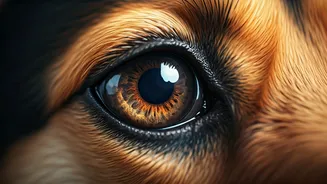Super Smell Power
Dogs are renowned for their exceptional sense of smell, far surpassing humans. They have an astounding number of olfactory receptor cells—up to 300 million,
compared to a mere 6 million in humans. This superior olfactory system enables dogs to detect odors at incredibly low concentrations, often a million times more sensitive than ours. Their brains also have a dedicated area specifically for processing smells, further enhancing their ability to analyze and interpret scent information. Dogs can differentiate between complex mixtures of smells, allowing them to identify individual scents and track trails with remarkable precision. Their wet noses also contribute to this ability, as the moisture helps trap scent particles. This amazing ability is also why dogs are used for detecting drugs, explosives, and even diseases.
Hearing: A Sonic Boom
Dogs possess extraordinary hearing abilities that far exceed those of humans. Their ears are designed to capture a wider range of frequencies, allowing them to hear sounds that are beyond human detection. They can hear sounds from 67 to 45,000 Hertz, while humans can only hear from 64 to 23,000 Hertz. The movable ears of dogs, which can swivel and tilt, help to pinpoint the exact direction of a sound. Dogs can also distinguish between sounds at greater distances compared to humans, meaning they are able to hear someone calling from far away. Furthermore, dogs are able to identify specific sounds, like the sound of a can being opened, which triggers excitement and anticipation. This keen sense of hearing is why dogs are so alert to their surroundings, often reacting to sounds that we don't even notice.
Vision: Seeing Differently
While not as acute as their sense of smell or hearing, dogs' vision is still remarkable. Their visual capabilities differ from humans, especially in terms of color perception. Dogs have dichromatic vision, meaning they primarily see in shades of blue and yellow, unlike humans, who have trichromatic vision and see a wider spectrum of colors. They do have a wider field of view compared to humans, approximately 240 degrees versus the 180 degrees in humans. This panoramic view allows them to detect movement and potential threats, especially those on their periphery. Furthermore, their eyes are built to function well in low-light conditions, aided by a reflective layer called the tapetum lucidum, giving them an advantage in the twilight hours. This helps explain why your dog might see things better in the dark than you do.
Taste: Flavor Exploration
Dogs' sense of taste is another area where they experience the world in a unique way. While the number of taste buds in dogs is less than in humans, they can still appreciate flavors. Dogs' primary taste receptors are sensitive to sweetness, sourness, and saltiness. Interestingly, they don’t appear to have the same ability to taste the umami flavor. Taste is also strongly connected to smell, and the two senses work together to provide a complete experience of flavor. This blend of senses enables them to enjoy the taste of food but also to distinguish it from other substances. This is also why certain foods become favorites for them, but that's not always the case.
Touch: Sensory Feedback
Touch plays an important role in how dogs interpret their environment and connect with others. Their bodies are covered with sensory receptors in their skin, which transmit information about temperature, pressure, and texture to their brain. These receptors are particularly concentrated in the paws, face, and lips, making these areas very sensitive to touch. Dogs often enjoy physical contact, such as petting, cuddling, and grooming, which can elicit feelings of comfort, security, and bonding. This sensory feedback helps them understand their surroundings, detect potential dangers, and establish relationships. These physical interactions also reduce stress and anxiety.
The Canine Sixth Sense
Dogs have a mysterious ability that goes beyond the five senses, sometimes called a sixth sense or intuition. This can involve detecting things humans cannot, such as recognizing when their owners are sad or sick. It may also be about predicting upcoming events, like a coming storm or the return of their owner. Some researchers propose that these perceptions stem from enhanced senses or a great awareness of subtle cues that humans frequently miss. Others argue that dogs possess a form of extrasensory perception, though concrete proof is hard to find. Whether it is an advanced understanding of social cues or genuine extrasensory perception, this sixth sense is yet another element that makes dogs unique.












